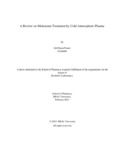| dc.contributor.advisor | Azam, Faruque | |
| dc.contributor.author | Pranto, Alif Hasan | |
| dc.date.accessioned | 2023-12-21T06:29:45Z | |
| dc.date.available | 2023-12-21T06:29:45Z | |
| dc.date.copyright | 2023 | |
| dc.date.issued | 2023-02 | |
| dc.identifier.other | ID 18346009 | |
| dc.identifier.uri | http://hdl.handle.net/10361/22022 | |
| dc.description | This thesis is submitted in partial fulfillment of the requirements for the degree of Bachelor of Pharmacy, 2023. | en_US |
| dc.description | Cataloged from PDF version of thesis. | |
| dc.description | Includes bibliographical references (pages 49-54). | |
| dc.description.abstract | Melanoma is the deadliest form of skin cancer. According to the American Cancer Society, melanoma kills 158,000 people annually. No melanoma vaccine has been approved. "Wide local excision" surgery is used to treat early-stage melanoma. The surgeon removes the tumor and a margin of normal skin. The surgeon will perform a sentinel lymph node biopsy to see if the melanoma has spread. Cold atmospheric plasma (CAP) generates two components: physical and chemical factors. Thermal, UV, and electromagnetic radiation destroy melanoma. RONS— reactive oxygen and nitrogen species—is another factor. Both factors increase immune cell-like T cells and helper T cells like CTD-4 and CTD-8 while decreasing B16F10. To treat B16F10 cell growth, cold atmospheric plasma changes the composition of tyrosine (tyr) and tryptophan (trp). Also, make changes in extracellular tissue pH to induce anti-cancer effects. Cold atmospheric plasma is affordable and easy to utilize, making it ideal for treating cancer cells. | en_US |
| dc.description.statementofresponsibility | Alif Hasan Pranto | |
| dc.format.extent | 54 pages | |
| dc.language.iso | en | en_US |
| dc.publisher | Brac University | en_US |
| dc.rights | Brac University theses are protected by copyright. They may be viewed from this source for any purpose, but reproduction or distribution in any format is prohibited without written permission. | |
| dc.subject | Melanoma | en_US |
| dc.subject | Cold atmospheric plasma | en_US |
| dc.subject | Reactive oxygen and nitrogen species | en_US |
| dc.subject | T cells | en_US |
| dc.subject.lcsh | Melanoma--Treatment. | |
| dc.subject.lcsh | Skin cancer | |
| dc.title | A review on melanoma treatment by cold atmospheric plasma | en_US |
| dc.type | Thesis | en_US |
| dc.contributor.department | School of Pharmacy, Brac University | |
| dc.description.degree | B. Pharmacy | |

